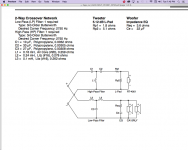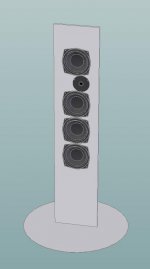It is more a loss as they separate. 2 bass drivers close together, and work together to give the expected +3 dB for doubling the drivers (and then on top whatever impedance/power effects), if they start to exceed that magic ¼ wavelength at their operating frequencies then they start to work likw 2 drivers instead of one.
dave
dave
I think MTM is a terriffic idea. I have listened to lots of varied MTM speakers.

This Scanspeak Mid/RAAL ribbon setup closely resembles my brother-in-law's 5.1 home cinema. As it goes, they are wall mounted which takes bafflestep out of the equation. He also has 4x 15" Scan basses mounted in the wall to free the 6" mids up from bass duties and excursion. He loves his sound and has a subscription to the Berlin Philharmonic's live video and audio feed for ultimate sound quality. 😀
Trust me on this, you actually can close your eyes and believe you are sitting in the front row at the Berlin venue! It's that good. 😎
This sort of quality comes from a huge financial investment (What? About £500,000....) and employing some of the best sound engineers in the World to set it all up.
We actually sat down together and tried some options. 2.1 Stereo worked really well for the central listener, but was not so good for the people sitting on the edges, where 5.1 worked better.
I also had a good listen about 30 degrees off-axis left, right, above and below. There was a "combing" hole in the midrange. But, TBH, it was no worse than any regular MT speaker. Let's remind ourselves that with the speed of sound being 340m/s, a half wavelength at 3.4kHz is 5 cms.
Back on-topic. IMO, series wired basses in a common enclosure work much better than parallel wired.
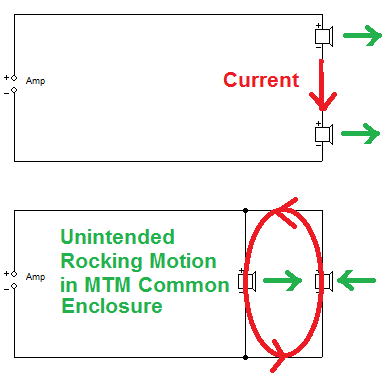
Any 18-y-o Physics student knows about Coupled Pendulums. And what the Physics tells me is that even the best amplifier in the World has no control over this coupling with parallel wiring. The basses actually take turns in doing the work. Which increases excursion and, hence distortion.
This Scanspeak Mid/RAAL ribbon setup closely resembles my brother-in-law's 5.1 home cinema. As it goes, they are wall mounted which takes bafflestep out of the equation. He also has 4x 15" Scan basses mounted in the wall to free the 6" mids up from bass duties and excursion. He loves his sound and has a subscription to the Berlin Philharmonic's live video and audio feed for ultimate sound quality. 😀
Trust me on this, you actually can close your eyes and believe you are sitting in the front row at the Berlin venue! It's that good. 😎
This sort of quality comes from a huge financial investment (What? About £500,000....) and employing some of the best sound engineers in the World to set it all up.
We actually sat down together and tried some options. 2.1 Stereo worked really well for the central listener, but was not so good for the people sitting on the edges, where 5.1 worked better.
I also had a good listen about 30 degrees off-axis left, right, above and below. There was a "combing" hole in the midrange. But, TBH, it was no worse than any regular MT speaker. Let's remind ourselves that with the speed of sound being 340m/s, a half wavelength at 3.4kHz is 5 cms.
Back on-topic. IMO, series wired basses in a common enclosure work much better than parallel wired.
Any 18-y-o Physics student knows about Coupled Pendulums. And what the Physics tells me is that even the best amplifier in the World has no control over this coupling with parallel wiring. The basses actually take turns in doing the work. Which increases excursion and, hence distortion.
Here's another interesting observation about this fantastic home cinema. And, TBH, there can be few in the World that are better.
If you really think about it, and Steen Duelund did, it makes no difference if the damping is in the speaker box or the room:
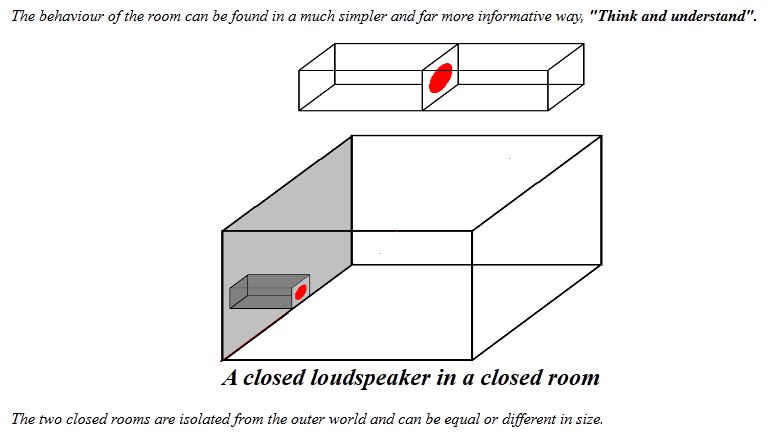
My Brother-in-law employs similarly minded Scandinavian engineers to line his walls in tapered rockwool around the drivers to get the nice sound.
If you really think about it, and Steen Duelund did, it makes no difference if the damping is in the speaker box or the room:
My Brother-in-law employs similarly minded Scandinavian engineers to line his walls in tapered rockwool around the drivers to get the nice sound.
Back on-topic. IMO, series wired basses in a common enclosure work much better than parallel wired.
And what the Physics tells me is that even the best amplifier in the World has no control over this coupling with parallel wiring. The basses actually take turns in doing the work. Which increases excursion and, hence distortion.
Thanks for the heads up. I only use series wiring in MTM's because I use 4 ohm mid woofers but good to know there are benefits.
you get a lot less deep bass in series as the woofer's Z at 30 to 50 hz can be as high as 40 ohms. Works great for midbass and midrange frequencies
Isn't the lesson to just use stiffer string if you're going to dangle your woofers in the air? I'm calling shenanigans.Back on-topic. IMO, series wired basses in a common enclosure work much better than parallel wired.

Any 18-y-o Physics student knows about Coupled Pendulums. And what the Physics tells me is that even the best amplifier in the World has no control over this coupling with parallel wiring. The basses actually take turns in doing the work. Which increases excursion and, hence distortion.
Most ideas in audio are really take it or leave it. It's up to you. 😀
But I think you would concede that if you have two woofers in a closed box, if you push one in, the other will pop out. This is my notion.
What is good about twin woofers wired in MTM or even MTTM series is they have equal loudness in the room whilst getting a quarter of the power individually, so distort considerably less. Two 4 ohm basses in series have a certain appeal.
Bottom line is we can get 6dB more loudness with MTM. Albeit more focussed horizontally, or cylindrical on dispersion to be precise. The PA principle which leads to 2X 12" basses or even 4X 12" stacked basses for bass guitar.
ShaneF did a terrific 5" SEAS CA15RLY MTM with a RT-4001 ribbon tweeter here:
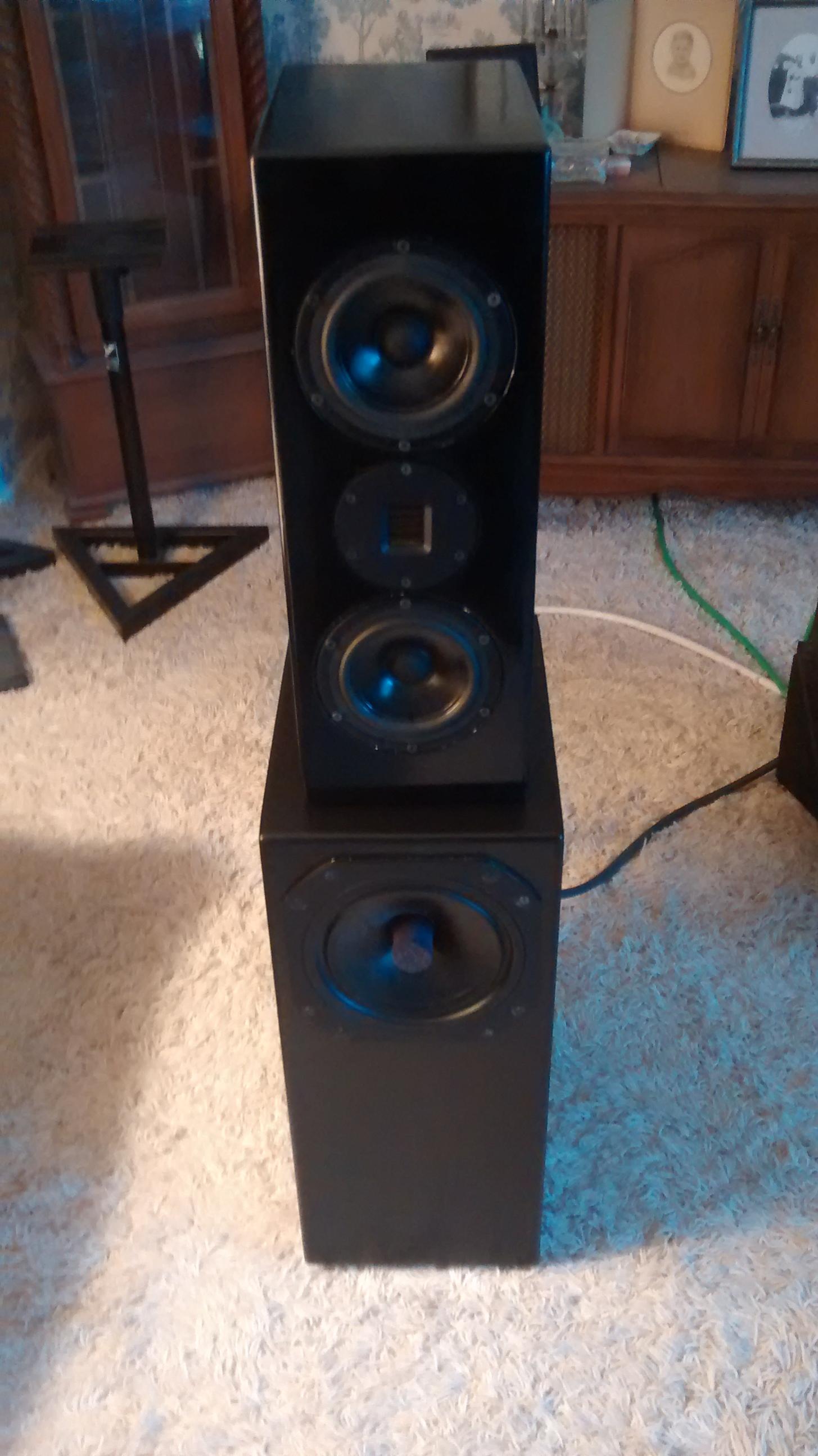
Of course he, wasn't going to go far wrong imitating the tested Gryphon Mojo:
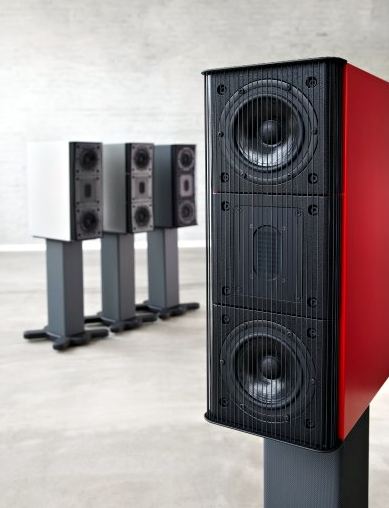
A lot to like there. The crossover suggested by Solen of Canada was an interesting third order design. No bafflestep worth mentioning, but you can add that if you want: mh-audio.nl - Home
These 3rd order designs with a 5" might work even better if you recess the basses to the back of the baffle and employ negative polarity. A standard BBC technique.
But I think you would concede that if you have two woofers in a closed box, if you push one in, the other will pop out. This is my notion.
What is good about twin woofers wired in MTM or even MTTM series is they have equal loudness in the room whilst getting a quarter of the power individually, so distort considerably less. Two 4 ohm basses in series have a certain appeal.
Bottom line is we can get 6dB more loudness with MTM. Albeit more focussed horizontally, or cylindrical on dispersion to be precise. The PA principle which leads to 2X 12" basses or even 4X 12" stacked basses for bass guitar.
ShaneF did a terrific 5" SEAS CA15RLY MTM with a RT-4001 ribbon tweeter here:
Of course he, wasn't going to go far wrong imitating the tested Gryphon Mojo:
A lot to like there. The crossover suggested by Solen of Canada was an interesting third order design. No bafflestep worth mentioning, but you can add that if you want: mh-audio.nl - Home
These 3rd order designs with a 5" might work even better if you recess the basses to the back of the baffle and employ negative polarity. A standard BBC technique.
Attachments
System7, think a mttm with morel cat378 is an ok option ?
I have luck with time aligned 6db on morel and eminence b102 wide open.
Looking for a bit more volume.........
Tweet is a horn loaded dome, 3.7" flange.
Morel CAT 378 1-1/8" Soft Dome Horn Tweeter
People like the tekton pendragon or enzo with its 3 dimple tweets.
Tekton Design Enzo XL loudspeaker | Stereophile.com
I have luck with time aligned 6db on morel and eminence b102 wide open.
Looking for a bit more volume.........
Tweet is a horn loaded dome, 3.7" flange.
Morel CAT 378 1-1/8" Soft Dome Horn Tweeter
People like the tekton pendragon or enzo with its 3 dimple tweets.
Tekton Design Enzo XL loudspeaker | Stereophile.com
Help with a 1.5 way series configuration
Hi there, I am a newbie also looking for some help on 1.5 way design using two very similar drivers. I am looking to use a pair of salvaged Tannoy CPA-5 ICT full range drivers along with a pair of salvaged Tannoy CPA-5 SB drivers (all 4 ohm nominal drivers rescued from damaged enclosures) I have had sitting around for a while. I am now looking to put them into a some new enclosures.
I have measured them using Dayton DATS system and the drivers are fairly close to each other in terms of Fs, sensitivity and impedance and appear (at this stage) to lend themselves well to a 1.5 way bass reflex configuration.
I don’t currently own an amp that is 2 ohm stable so that puts a parallel connection out the picture, so looking to go 1.5 way series connection with them.
My question is, and referring to 404 Error - Page Not Found, would my capacitor calculation be based on the Rdriver at the filter frequency for both drivers in series, or just the mid bass needing the low pass?
For example if I calculate the Rdriver at the filter frequency for both drivers in series I get:
39uF (based on an Rdriver of 7.1 ohms at a fbs of 570hz 20cm baffle width)
and for just the mid bass driver:
77uf (based on ab Rdriver of 3.55 at a fbs of 570hz 20cm baffle width)
Apologies if this sounds like a stupid question but before I order any capacitors, I would just like some clarification over whether the impedance at baffle step for the capacitor calculation is based on the pair in series or just the mid bass.
I am leaning towards the capacitor values based on just the mid bass (based on where the bypass capacitor sits in the circuit) but any help on the matter is most appreciated.
Cheers
Zeek
2 identical drivers in series with one having a shunt cap to roll it off gives you a 1.5 way system with no baffle step gain (unless you are using a current amp. You get 3 dB extra because of 2 drivers, but double impedance means you lose 3 dB becaus ethe amplifier is outputting half at the lowest frequencies.
http://www.planet10-hifi.com/downloads/Dual-Driver-Wiring.pdf
Having different drivers with different sensitivities complicates thing.
dave
Hi there, I am a newbie also looking for some help on 1.5 way design using two very similar drivers. I am looking to use a pair of salvaged Tannoy CPA-5 ICT full range drivers along with a pair of salvaged Tannoy CPA-5 SB drivers (all 4 ohm nominal drivers rescued from damaged enclosures) I have had sitting around for a while. I am now looking to put them into a some new enclosures.
I have measured them using Dayton DATS system and the drivers are fairly close to each other in terms of Fs, sensitivity and impedance and appear (at this stage) to lend themselves well to a 1.5 way bass reflex configuration.
I don’t currently own an amp that is 2 ohm stable so that puts a parallel connection out the picture, so looking to go 1.5 way series connection with them.
My question is, and referring to 404 Error - Page Not Found, would my capacitor calculation be based on the Rdriver at the filter frequency for both drivers in series, or just the mid bass needing the low pass?
For example if I calculate the Rdriver at the filter frequency for both drivers in series I get:
39uF (based on an Rdriver of 7.1 ohms at a fbs of 570hz 20cm baffle width)
and for just the mid bass driver:
77uf (based on ab Rdriver of 3.55 at a fbs of 570hz 20cm baffle width)
Apologies if this sounds like a stupid question but before I order any capacitors, I would just like some clarification over whether the impedance at baffle step for the capacitor calculation is based on the pair in series or just the mid bass.
I am leaning towards the capacitor values based on just the mid bass (based on where the bypass capacitor sits in the circuit) but any help on the matter is most appreciated.
Cheers
Zeek
"capacitor values based on just the mid bass" - yes
Thanks for the quick response and for clarifying that. I can go ahead and order some caps now. 🙂
I've been experimenting with this for a while using Equalizer APO as the crossover in an active system.
Overlapping the frequencies of drivers is great when they are playing lower frequencies (mutual coupling).
Once lobing starts though it has a very negative effect on the sound, dynamics, and to some extent imaging. Though I will say that the symmetrical lobing in an MTM is subjectively much more tolerable, and even helps a bit with floor and ceiling bounce. Line arrays actually overcome lobing by having a stack of drivers, so there really isn't lobes that form.
I imagine that the sound of a two way with a series crossover would sound pretty weak.
Overlapping the frequencies of drivers is great when they are playing lower frequencies (mutual coupling).
Once lobing starts though it has a very negative effect on the sound, dynamics, and to some extent imaging. Though I will say that the symmetrical lobing in an MTM is subjectively much more tolerable, and even helps a bit with floor and ceiling bounce. Line arrays actually overcome lobing by having a stack of drivers, so there really isn't lobes that form.
I imagine that the sound of a two way with a series crossover would sound pretty weak.
Last edited:
- Status
- Not open for further replies.
- Home
- Loudspeakers
- Multi-Way
- 2.5 way crossover how it works?
